Log in or create new account to save this product to your wishlist.
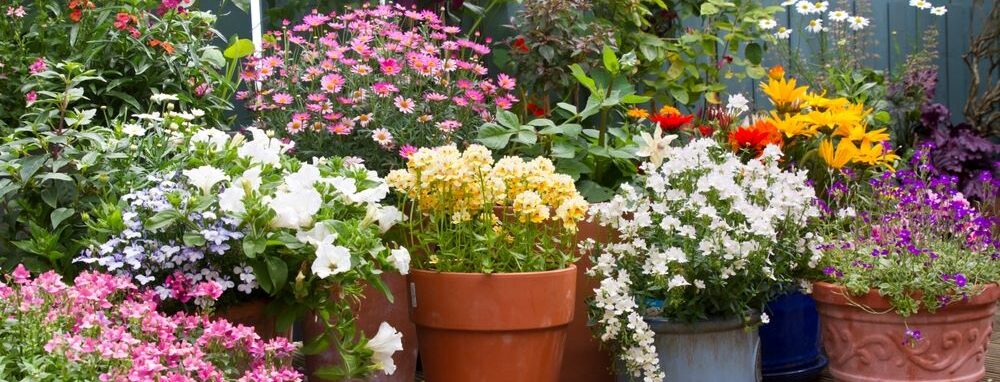
Getting Started with Container Gardening
Growing plants in containers has a wide range of benefits. Brighten up your patio or a shady corner of your garden with plants in pots! Find out how to choose the right plants!
🌱 All important maintenance moments for your lawn during the year. Leave your email and we will send you the lawn calendar for free.
Enter your email
Receive the lawn calendar in the mail
Enjoy a green lawn all year round!

- Order by 2PM = shipped today
- 250.000+ satisfied customers!
- 60 day satisfaction guarantee
Container gardening: an innovative and flexible approach to gardening, offering a myriad of opportunities to gardeners of all skill levels. People choose to grow flowers, veg, and fruit in pots to save space, stay in greater control of the soil, and just because blooming pots look nice — brightening up dull patios and yards.
- What is Container Gardening?
- Choosing the Right Containers for Your Garden
- Preparing Your Containers for Planting
- Selecting Plants for Your Container Garden
- Watering a container garden
- Fertilising your container garden
- Seasonal container gardening
- Troubleshooting common container gardening problems
- FAQs
From the beginner dipping their toes into the world of plants to the seasoned gardener looking for a fresh project, container gardening caters to everyone with an enthusiasm for growing flowers, fruit, veg, and even shrubs and small trees.
Whether you’re restricted by space or simply appreciate the versatility of growing plants in pots, this guide to container gardening is here to help you get started.
I can sense your readiness! Let’s get started.
What is Container Gardening?

Container gardening, as the name implies, is about growing plants in containers rather than in the ground.
This form of gardening has a multitude of advantages:
- It’s flexible
- Accessible, and
- Allows for a high level of creativity
As a style of gardening, it’s unbound by the limitations of traditional gardening and, instead, opens up an entirely new dimension of possibilities.
The Flexibility of Container Gardening
The beauty of gardening in pots lies in its versatility.
It’s the perfect solution for those with limited space or poor soil conditions, from a tiny balcony in a city apartment to a sprawling patio in a suburban home.
Indeed, if you have a “yarden”, you may feel doomed to look out at an uninspiring concrete square for the rest of time. But you don’t need a lawn and flowerbeds to make a beautiful outdoor garden space. Because growing colourful and abundantly blooming plants and bushes in pots is the ideal solution.
Container gardening allows you to nurture a broad selection of plants, from herbs and vegetables to flowering plants and even small trees, right outside your back door.
Container Gardening: An Accessible Approach
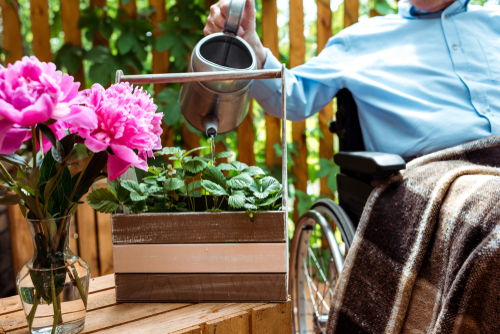
Another appealing aspect of container gardening is its accessibility, allowing people of all abilities to engage with nature and benefit from the therapeutic benefits of gardening.
If you can’t bend down to floor level, then place your containers on platforms that are easy to reach. If you don’t have the energy to dig up your flowerbeds, cover them with gravel or mulch and place containers in their place.
Container gardening is also an excellent chace for beginners to dip their toes into amateur horticulture. As a beginner, you can learn about different plants, understand their needs, and gain hands-on experience with minimal risk.
Unleashing Creativity with Container Gardening
Container gardening is as much about creativity as it is about growing plants. Access an exciting platform to experiment with different plant combinations, pot designs, and arrangement styles.
Whether you’re going for a uniform look with matching pots or a more eclectic style with a mix of containers, the scope for personal expression is immense.
And containers don’t necessarily need to use up floor space: wall-hung containers are excellent choices for trailing plants and beautifying (or disguising) ugly or crumbling walls.
Containers give you control over your gardening soil
When you move into a new home, you inherit a garden. So, you’re largely at the mercy of luck regarding the quality of your garden soil. It might be too heavy and easily waterlogged, or it might be too sandy, quickly losing its moisture and nutrient content.
So, one of the biggest attractions of container gardening is the ability to control your soil.
Fill your pots with good-quality compost; your plants will repay you in abundance.
Choosing the Right Containers for Your Garden
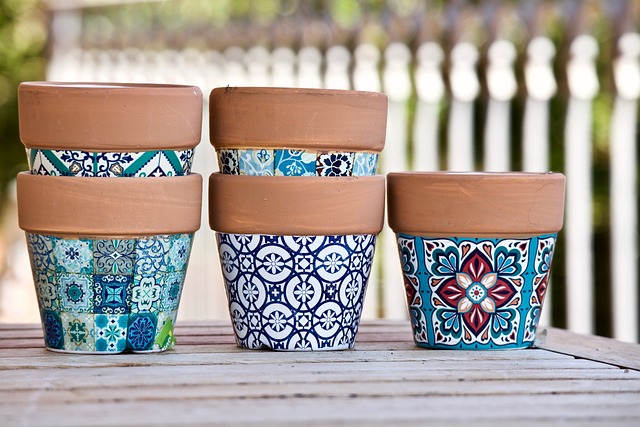
When choosing containers for your garden, various options are at your disposal. The possibilities are endless, from traditional terracotta pots to creative upcycled DIY containers made from old pallets and car tyres.
However, it’s crucial to select containers that look appealing and support your plants’ growth and health.
Size Matters
The size of the container plays a crucial part in the successful growth of your plants.
So, choose a pot that provides ample space for the plant to thrive, both above and below the soil. It’s always a good idea to know how big a plant is likely to get and accommodate it accordingly.
Consider:
- Will the plant become top-heavy — it’s likely to topple over?
- Will the container allow the roots to spread?
Large containers hold more soil and stay moist for longer; they’re more resistant to rapid temperature changes than smaller pots.
When a plant is too big for its container, the soil will dry out quickly, so you’ll have to water more frequently.
Drainage is Essential
No matter how attractive a container may look, it’s not a good choice for your plants
if it lacks adequate drainage.
Ultimately, the soil becomes waterlogged without proper drainage, leading to root rot and other diseases.
Ensure your chosen container has enough holes to allow excess water to drain out. Drill extra holes if the soil is getting too wet.
How to improve drainage in decorative pots
However, you might not want to drill into expensive, decorative pots. In this case, use the decorative pot to house a slightly smaller, well-draining pot. Place broken pieces of terracotta or stones in the bottom of the decorative pot, and place the potted plant on top of the broken pieces — it will help with drainage.
Material Choices
Containers come in a variety of materials, each with its own set of advantages and disadvantages.
Terracotta or clay containers are visually appealing but can be fragile, while plastic and fibreglass pots are lightweight and affordable.
Wood and metal containers have their unique charm but have certain drawbacks. Wood can decay over time, and metal containers can conduct heat, affecting the root temperature of your plants.
So, if you’re placing your pots in sunny areas, perhaps avoid metal pots, as they can overheat (and you’ll need to water more regularly to keep the plant happy).
Preparing Your Containers for Planting
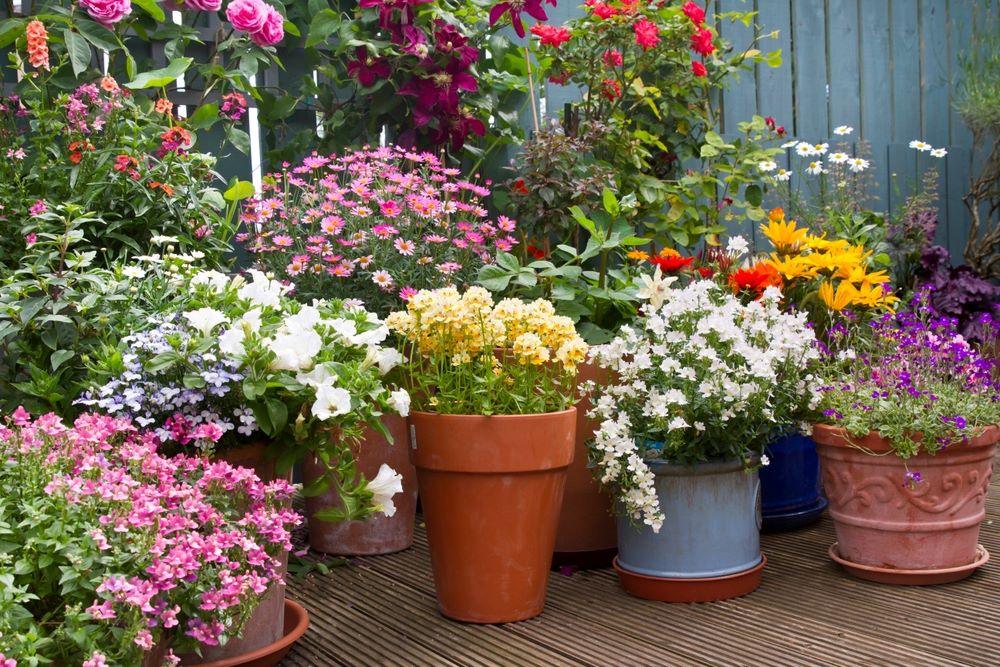
Once you’ve chosen suitable containers for your garden, the next step is to prepare them for planting. This involves ensuring proper drainage, selecting the right soil, and positioning your containers correctly.
Ensuring Proper Drainage
While ensuring your containers have drainage holes is crucial, it’s equally important to prevent soil from washing out of these holes.
A simple solution is to place a layer of newspaper over the holes before adding your soil mix.
And if the pot doesn’t have enough holes, place a layer of broken terracotta or big stones in the bottom of the pot before filling it with soil — it will help keep soggy soil away from roots.
Selecting the Right Soil
Regular garden soil is often too heavy for container gardening.
Instead, opt for a lightweight, nutrient-rich potting mix from the garden centre. Alternatively, you could use well-rotted homemade compost.
For larger containers, use a coarse, soil-less planting mixture to maintain the right balance of water and air.
Positioning Your Containers
Containers can be heavy once filled with soil and plants.
So, it’s a good idea to decide where to locate them and move them into position before filling and planting them.
Consider the sunlight and shade your plants need, and place your containers accordingly. Remember, not all plants need or desire direct sunlight — if you have a shady outdoor space, check out our expert’s guide to choosing plants for a shaded garden.
Selecting Plants for Your Container Garden
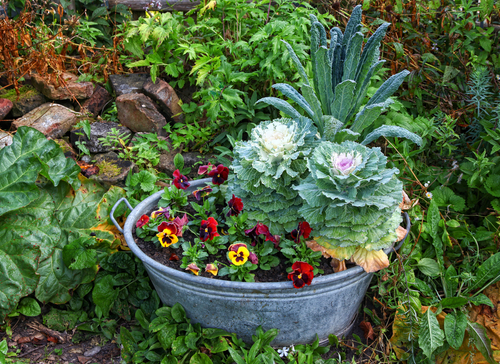
You can let your imagination run wild when selecting plants for your container garden. Almost any vegetable, flower, herb, shrub, or small tree can grow successfully in a container if the conditions are right.
Keep in mind the climate, amount of sun or shade, and the size of your container when choosing your plants.
The Art of Plant Combination
One of the most creative aspects of container gardening is the ability to combine different plants in a single container. You could choose a single species for a dramatic effect or mix and match for a colourful display.
Thriller, spiller, filler
A popular approach for container planting is to include “a thriller, a spiller, and a filler.”
This means having one focal plant (the thriller), several trailing plants (the spiller), and some smaller plants to fill in the gaps (the filler).
Container Gardening with Vegetables and Herbs
Container gardening isn’t just for decorative plants; it’s also a practical way to grow vegetables and herbs.
Many edibles are very happy growing in pots, which can be conveniently located near your kitchen for easy access.
Basil, thyme, chives, and other herbs, as well as vegetables like tomatoes, peppers, and lettuce, can all thrive in containers.
Here are some veg/fruits you might be surprised are happy in pots:
- Potatoes
- Strawberries
- Broad beans
- Beetroot
- Radishes
- Chilis
- Peppers
- Lettuce, rocket, and other salad leaves
- Peas
- Carrots
- Spring onions
- Tomatoes
So, it’s entirely possible to live The Good Life without a tiny, sunny yarden!
Watering a container garden
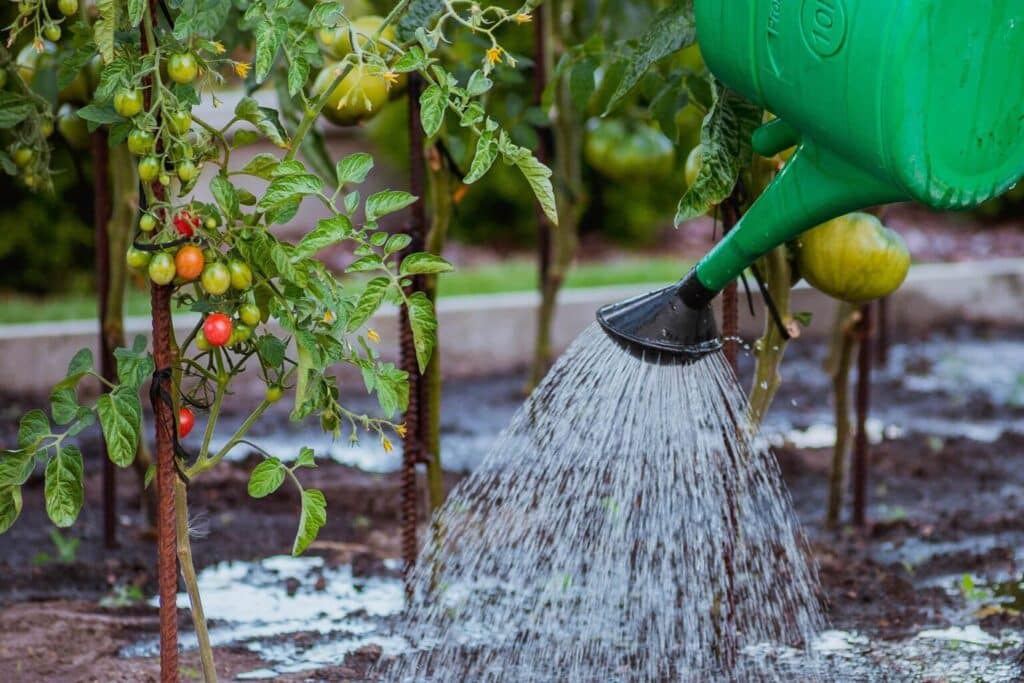
Now for the main downside of container gardening: the soil dries out much more quickly than typical garden soil. This is a bonus for plants that crave dry soil, like lavender, philodendron, spider plants, philodendron, stonecrop, and jade — but most pot plants need regular watering.
There’s no one rule — it depends on the needs of each plant you choose and the weather. For example, in the height of a hot summer (remember those?), you might need to water your pots twice a day to prevent them from drying out. But they might not need watering at all during periods of heavy rain (also known as a UK summer!).
When should I water my container garden?
The best time of day to water your plants is in the morning before the sun is too intense. Alternatively, water the soil in the evening, but not if the temperature drops, as this can cause soggy soil that rots the plant’s roots.
It’s generally better to water the soil directly, avoiding getting the plant’s foliage wet, as wet leaves can burn in direct sunlight or promote fungal infections overnight.
Fertilising your container garden
While containers allow you to control the soil, you also confine your plant to soil of finite nutrient resources. In other words, you’ll need to fertilise your containers more regularly than you might feed the soil in your flower beds.
Buy a fertiliser designed for outdoor pots and follow the instructions. But, typically, begin feeding in spring and continue through the summer and autumn every two weeks.
When your container plants grow vigorously, feed once a week for small pots and twice a week for large containers housing fast-growing plants. Bear in mind, that this relates to liquid feed, not slow-release fertiliser, which you typically use much less regularly. Either way, always following the instructions on the packet to ensure you don’t over-fertilise.
Seasonal container gardening
Here are some tips to ensure you get the best out of your container garden:
- Plant perennials and evergreens in pots in early spring. They’ll establish more quickly, but early autumn may be OK, depending on the plant.
- Plant tender, summer-flowering plants in May or early June once the frost risk has passed.
- For winter displays, plant your winter-flowering plants in autumn.
- Plant spring bulbs in autumn, giving them a chance to settle in the soil before they burst into life in spring.
Troubleshooting common container gardening problems
If you encounter poor growth in your outdoor pots, it’s essential to determine the cause before taking appropriate action.
Here are some common problems:
- Plants are wilting — one frequently encountered issue with container gardening is insufficient drainage, causing plants to wilt despite having enough water. Resolve this by ensuring that the container has enough holes for water to drain out properly or adding broken terracotta or large stones in the bottom of the pot to help water drain away from the roots.
- Poor or short flowering window— your plants could be suffering from a lack of sunlight. So, move any plants that aren’t thriving into a sunnier spot.
- Poor growth — nutrient deficiency is a common issue in containers because the soil has a smaller resource of natural nutrition. Alleviate the problem by applying a good-quality fertiliser regularly.
- Yellowing, damaged, and falling leaves — pests and diseases can thrive in container conditions, so regular inspections and prompt action are crucial. Pruning can help maintain airflow and prevent fungal infections. Cut back dead or diseased growth, allowing the plant to draw energy into its healthy limbs.
FAQs
Container gardening offers several benefits, including growing plants in limited space. It provides flexibility in controlling growing conditions like soil type, moisture, and sunlight, making it perfect for urban dwellers. Container gardening also allows for easy relocation of plants based on the weather and sunlight requirements and can reduce pest and disease problems.
Container gardening accommodates a wide range of plants. Vegetables like tomatoes, peppers, and herbs can thrive in containers. Many types of flowers, including marigolds, petunias, and begonias, are also suitable. Succulents and dwarf varieties of larger plants are excellent choices as well. It’s crucial to consider the plant’s size, growth habits, and light and water needs.
Maintaining a healthy container garden involves sufficient water, sunlight, and nutrients. Ensure your container has drainage holes to prevent water-logging. Place your plants in a location with appropriate light exposure, and feed them with a balanced fertiliser. Check for pests and diseases, and take prompt action when needed. Pruning can also help maintain plant health and stimulate growth.
Any questions?
I hope I’ve provided all the information you might need to start your container gardening project. But if you have any questions, don’t hesitate to get in touch.
Alternatively, check out our super-comprehensive Help & Advice section — for expert tips on everything garden and lawn related.
Thanks for reading! And happy container gardening!
-
Orchids: A Complete Guide on How to Care for ThemWant to give your orchid the best possible care? Discover essential tips from placement to watering and pruning. Learn everything you need to know!Read more
-
Growing Wisteria Made Simple: From Planting to Perfect BloomsWith blossoms like a purple waterfall, Wisteria sets an almost magical and colourful mood. If you want to grow this beauty in your garden, you’ll need a bit of patience. Don’t worry, it will most definitely pay off.Read more
-
How to Build a DIY Greenhouse: A Practical Guide for Smart SpendersImagine extending your growing season throughout the year, nurturing tender plants regardless of the weather, and creating a personal garden sanctuary. This is precisely what a DIY greenhouse offers you. Let’s learn how to build one.Read more
-
How to Grow Eucalyptus in British GardensWith a little love and care, eucalyptus trees can thrive in English gardens. Since they don’t germinate well without proper help, there are not considered invasive. So, there is no reason not to plant them if you enjoy their looks.Read more
-
Transform Your Garden with All-Year-Round Flowering PlantsDid you know you can enjoy blooming flowers even in January? With the right selection of all year round plants, there’s no need to wait until spring to add some colour to your garden.Read more
-
How to Create a Butterfly Garden: A Simple Guide for British GardensThe UK's butterfly population includes 59 different species. These beautiful winged creatures face a steady decline because of habitat loss, pollution and changing weather patterns. Your garden can become a vital link between nature reserves and natural habitats. Let’s explore how.Read more
-
Volcanic Rock Dust for Your Garden—Application and TipsDid you know that volcanic rock dust is a brilliant organic soil improver? This article explains exactly what it's good for and how to use it properly.Read more
-
How to Use Landscape Fabric ProperlyIf weeds or erosion in your garden are troubling you, landscape fabric might be the solution. We’ll explain how and when to use it properly, just keep on reading.Read more
Leave a comment
Your answer will be displayed on the site and the interested party will be notified by email.
Leave a comment
Have a question or want to share your experience? Leave us a comment.

- Order by 2PM = shipped today
- 250.000+ satisfied customers!
- 60 day satisfaction guarantee

- Order by 2PM = shipped today
- 250.000+ satisfied customers!
- 60 day satisfaction guarantee

🌱 All important maintenance moments for your lawn during the year. Leave your email and we will send you the lawn calendar for free.
Enter your email
Receive the lawn calendar in the mail
Enjoy a green lawn all year round!






















Comments (0)
There are no comments yet. Well then, what are you waiting for to
Be the first to write your comment!inaugurate this pretty page?
Do you have some comments?